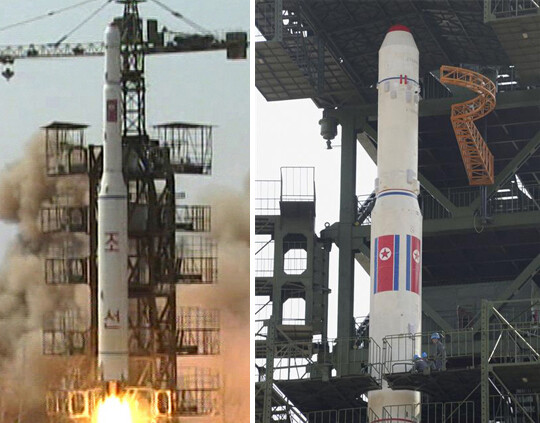hankyoreh
Links to other country sites 다른 나라 사이트 링크
North’s new rocket ‘virtually identical’ to 2009

By Lee Soon-hyuk, staff writer and Jung Nam-ku, Tokyo correspondent
Experts generally agree that the Unha-3 rocket revealed by North Korea is much like the Unha-2 launched in 2009.
Speaking in an interview with the NHK network, former Japan Maritime Self-Defense Force rear admiral Tsutomu Taguchi said the rocket was “virtually identical” in form and size to the Taepodong-2 launched three years ago.
“It looks like this launch is intended to see whether the missile will fly and the boosters separate as programmed,” Taguchi added.
Noting the confirmed presence of four engine jets beneath the first-stage rocket, Taguchi said, “It had been suspected that the Taepodong-2 involved binding together four mid-range ‘Rodong’ ballistic missiles, but this is the first time we‘ve had video confirmation.”
Korea Aerospace Research Institute senior researcher Chae Yeon-seok said an examination of the released footage indicated that the rocket may be more or less the same as the Unha-2 launched in 2009.
“The first-stage booster looks to be made up of four Rodong missiles with a driving force of about 30 tons each, and the Unha-2 was also believed to have an initial driving force of about 120 tons,” Chae explained.
According to data revealed Sunday by North Korea, the Unha-3 has an initial thrust of 120 tons and a diameter of 2.4 meters, weighs a total of 91 tons, and is 30 meters long.
Experts said the rocket unveiled by North Korea would fall short of intercontinental ballistic missile (ICBM) capabilities if used as a missile.
Noting that an ICBM needs to be capable of traveling at least 6,500 to 7,000km, Korea Aerospace University professor Chang Young-keun said that if the first-stage booster of a three-stage rocket has an initial driving force of 120 tons, the farthest it could go with a missile would be 5,000 to 6,000km.
A remaining question involves the difference in range between the Unha-2 and Unha-3, which are virtually identical in technology and performance. In its 2009 launch, the Unha-2 saw its second-stage booster travel 3,846 km to the east before falling into the Pacific.
North Korean authorities said the second-stage booster for the Unha-3 would travel about 2,500 km to the south before falling into the East China Sea off the coast of the Philippines, indicating a 1,000 km reduction in the second-stage booster range.
A military official said, “While there’s no real difference in the rocket technology between a missile and a satellite, the goal with a missile is to make it go far, and the goal with a satellite is to launch it high so that its payload goes into orbit.”
“It seems like the large reduction in range is evidence that North Korea is focusing more on making [the satellite] go high this time,” the official added.
An expert from a government think tank who spoke on condition of anonymity said North Korea appeared poised to go ahead as with a real satellite launch, as evidenced by the decision to invite foreign journalists to the launch site.
“In cases like this, you need to focus more on boosting confidence in the technology than on increasing the size or range of the missile,” the official added.
Please direct questions or comments to [english@hani.co.kr]
Editorial・opinion
![[Column] Season 2 of special prosecutor probe may be coming to Korea soon [Column] Season 2 of special prosecutor probe may be coming to Korea soon](https://flexible.img.hani.co.kr/flexible/normal/500/300/imgdb/original/2024/0426/3317141030699447.jpg) [Column] Season 2 of special prosecutor probe may be coming to Korea soon
[Column] Season 2 of special prosecutor probe may be coming to Korea soon![[Column] Park Geun-hye déjà vu in Yoon Suk-yeol [Column] Park Geun-hye déjà vu in Yoon Suk-yeol](https://flexible.img.hani.co.kr/flexible/normal/500/300/imgdb/original/2024/0424/651713945113788.jpg) [Column] Park Geun-hye déjà vu in Yoon Suk-yeol
[Column] Park Geun-hye déjà vu in Yoon Suk-yeol- [Editorial] New weight of N. Korea’s nuclear threats makes dialogue all the more urgent
- [Guest essay] The real reason Korea’s new right wants to dub Rhee a founding father
- [Column] ‘Choson’: Is it time we start referring to N. Korea in its own terms?
- [Editorial] Japan’s rewriting of history with Korea has gone too far
- [Column] The president’s questionable capacity for dialogue
- [Column] Are chaebol firms just pizza pies for families to divvy up as they please?
- [Column] Has Korea, too, crossed the Rubicon on China?
- [Correspondent’s column] In Japan’s alliance with US, echoes of its past alliances with UK
Most viewed articles
- 1‘We must say no’: Seoul defense chief on Korean, USFK involvement in hypothetical Taiwan crisis
- 2After election rout, Yoon’s left with 3 choices for dealing with the opposition
- 3Why Kim Jong-un is scrapping the term ‘Day of the Sun’ and toning down fanfare for predecessors
- 4Noting shared ‘values,’ Korea hints at passport-free travel with Japan
- 5AI is catching up with humans at a ‘shocking’ rate
- 6Two factors that’ll decide if Korea’s economy keeps on its upward trend
- 7Amnesty notes ‘erosion’ of freedom of expression in Korea in annual human rights report
- 8[Editorial] Korea’s surprise Q1 growth requires objective assessment, not blind fanfare
- 9A week of protests lays bare many inherent vices of Korean health care system
- 10Yoon says collective action by doctors ‘shakes foundations of liberty and rule of law’